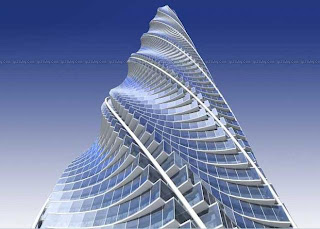Since the time of great empires, architecture has been a way for civilizations to assert their power, flaunt their wealth, and celebrate their genius. China has made a grand statement with the five new buildings it birthed for this 2008 Olympic Games in Beijing.

The National Stadium by Swiss architects Jacques Herzog and Pierre de Meuron
Photo by Ciaro Cortes IV/Reuters
The National Stadium, nicknamed the bird's nest for its asymmetrical, seemingly stretched steel columns that wrap the building, is a feat in the idea of public access. This building is open celebrates the openness of the walls, right down to the ground, with access on all sides the building. The intricate truss systems make steel look as flimsy as a piece of straw. The translucent plastic allows light to enter during the day, only to become a beacon at night.

The National Aquatics Center by PTW Architects, CSCEC International Design, Arup
The National Aquatics Center is know as the water cube, a contradiction in terms, but a beautiful one. Thousands of steel and ETFE cells are contained by a rectilinear form. Each cell captures heat, which serves to keep the interior at a regulated temperature. Ah, the beauty of modern engineering.

Beijing International Airport Terminal 3 by British architect Norman Foster
China embraces modern constantly moving society with this terminal featuring curved walls, a sloped floor, and curved ceiling that usher crowds through terminals to the main concourse. "This terminal is the world's largest building and would stretch across lower Manhattan" (NYT).

The National Theater by French architect Paul Andreu
Another reference, from nature, the National Theater has been compared to a floating pearl or an egg. It's surrounded by a moat, which cuts it off from the rest of the city and forces those who enter to traverse underground to then reemerge in the building. It's been compared to Tiananmen Square's relationship to the city with its own underpasses. The structure seems to be one with the water that surrounds its, with the mutual reflection between the water and the building envelope.

CCTV Headquarters by Dutch architect Rem Koolhaas
I saved the best for last, in my humble opinion. This goes back to the old Lego-inspired architecture for me, but with a beautiful asymmetrical twist that causes the passerby to never see the building the same way twice. It transforms in front of one's eyes at every angle. The diagonal steel structures were originally designed along the entire building, but were taken away in strategic places were the load was less. Like two interconnecting Tetris pieces, the structure hovers 36 stories over a vast plaza at this site of the China's state television network. Koolhaas's intention was for the plaza to be public, but time will tell whether the government will allow it. It's another example of the changing face of the nation.
I got most of my information from a. Aug. 5 article from the New York Times. Check out these links.
For the New York Times article by Nicolai Ouroussoff
:










